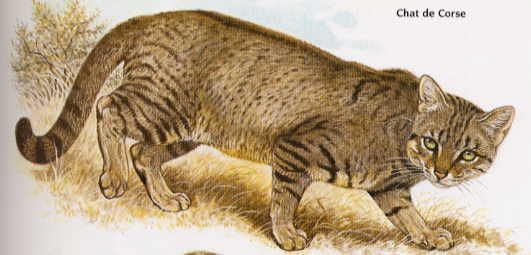|
|
Post by another specialist on Jul 18, 2007 8:02:12 GMT
Interestly, the wild cats found on the mediterranean islands are of african rather than european lineage. The corsican wild cat = Felis Lybica Reyi is perhaps the most mysterious of the cats from this region, because it is only documented from studies carried out in 1929. While l. lavauden was investigating reports of a lynx on the island, a teacher brought him the skin and skull of a wild cat. It had been killed in the foret d'aunes, south of bastia. The creature differed significantly from any of the others, it had a much shorter tail and its coat was very dark, as could be expected from a forest dwelling cat. it also lacked the russet tinge on the hair behind the ears. the distinctive feature of african wild cats, a black mark on the sole of the hind feet, continuing between the toes,was, however, apparent. This suggested to lavauden that the cat was more closely related to the african than the europeon races. A further 2 skins were later obtained from the same source, but no further specimens have subsquently been reported. the skins themselves were passed to the musee de grenoble at isere. the warden of the area, a monsieur rotges, confirmed that these cats were not apparently rare at that time. they could be seen not only in forested upland areas, but also in more open country. since then, however, it appears likely this race has became extinct. |
|
|
|
Post by another specialist on Jul 18, 2007 8:02:46 GMT
info from Wild Cats of the World David Alderton  Paperback 192 pages (June 4, 1998) Publisher: Cassell Illustrated ISBN: 0713727527 |
|
|
|
Post by another specialist on Jul 18, 2007 8:05:55 GMT
The Mediterranean Wildcats on the Balearic Isles, Crete, Sicily, Sardinia and Corsica, though part of the Felis sylvestris species, have been identified as belonging to the African subspecies, not the European subspecies. The Majorcan wildcat is officially extinct, though there have been sightings of cats closer in type to wildcats than to domestic cats. The purebred Cretan wildcat may become extinct through interbreeding with domestic cats. The Sicilian and Sardinian Wildcats are closest in form to the African Wildcat. The Corsican Wildcat is known from a handful of specimens and is possibly extinct. In 1929 it was reported that lynxes were present on Corsica, but analysis of a skin showed it to be a Wildcat akin to the African Wildcat. The Ile du Levant Wildcat on the Ile du Levant (one of the Mediterranean Iles d'Hyères off the coast of the Var, France) has been observed and killed in traps, but not presented for examination and formal identification. In 1932 it was known as the Paille Lynx due to its size. In 1958, one was observed attacking feral domestic cats members.aol.com/jshartwell/anomalous-bigcats.html |
|
|
|
Post by another specialist on Jul 18, 2007 8:10:02 GMT
sending on the page two pictures. Second is picture of corsican wildcat (F.s.reyi) from internet page planet-mammiferes.org |
|
|
|
Post by another specialist on Jul 18, 2007 8:11:28 GMT
 Felis silvestris reyi |
|
|
|
Post by another specialist on Jul 18, 2007 8:12:32 GMT
Felis silvestris reyi:  from book: Die Wildkatzen der Alten Welt, Haltenorth Th. (1953) Leipzig |
|
|
|
Post by another specialist on Jul 18, 2007 8:13:02 GMT
Thanks Baghira for the last images there great. First time i've seen any of them. |
|
|
|
Post by another specialist on Sept 11, 2007 4:59:16 GMT
|
|
|
|
Post by another specialist on Aug 9, 2008 17:05:09 GMT
|
|
|
|
Post by another specialist on Jul 15, 2021 15:32:05 GMT
|
|